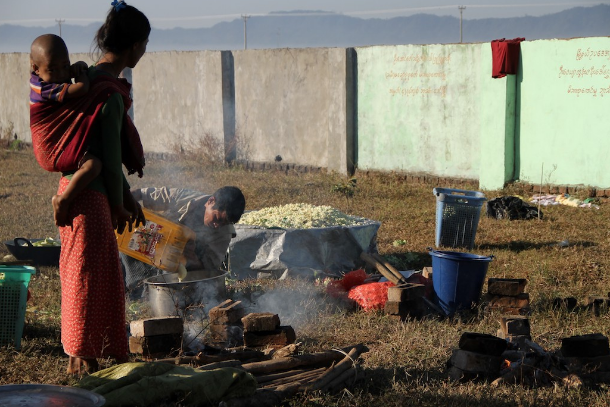With the world’s eyes on the Rohingya crisis, Buddhists in Rakhine State aim to win sovereignty by force

A
Tibor Krausz, Bangkok 11 February 2019
Militant ethnic separatism has been on the rise among indigenous Buddhists in Myanmar’s Rakhine State even as most international attention has been focusing on the plight of Muslim Rohingya, seasoned Myanmar watchers say.
The Arakan Army, a well-armed insurgent group known for its slick recruitment videos on social media, has been enjoying widespread and increasing support among ethnic Rakhine people for its guerrilla-style attacks against government forces, they say.
“The Arakan Army has expanded to a force of [several thousand] soldiers,” David Scott Mathieson, a security analyst and human rights expert formerly with Human Rights Watch, told a gathering of foreign journalists in Bangkok. “They have had lots of recruits and very good training. The scale and geographic reach of their activities have steadily grown.”
The guerrilla outfit is a relatively new fighting force in Myanmar’s seething cauldron of ethnic rivalries. Set up in 2009 by a small group of young ethnic nationalists, the Arakan Army has been going from strength to strength in recent years.
Yet the rise of an armed insurgency among indigenous Buddhists who predominantly live in villages on remote mountainous terrain has been largely overshadowed by the Burmese army’s coordinated offensives against Muslim Rohingya people in Rakhine.
Top of Form
In 2016 and 2017, hundreds of thousands of Rohingya fled into neighboring Bangladesh after attacks by the Arakan Rohingya Salvation Army on Burmese security forces triggered a heavy-handed response.
“This is an insurgency that people have taken their eyes off in recent years, but we should be paying closer attention to it,” Mathieson says.
Richard Horsey, a Yangon-based political analyst, says the insurgency marks a shift from politics to armed struggle.
“Locals are feeling politically marginalized. They don’t feel like a part of Myanmar but they also don’t feel like a part of the periphery. They feel they belong to their own sovereign state,” he says.
“It’s a very strong sentiment. They have concluded that the political route is not working and they are seeking to take back their sovereignty [by force of arms].”
The insurgent group which wants to achieve that appears to be well financed. Some analysts suspect it may be engaged in the lucrative trade of methamphetamine in Kachin State, where it first emerged.
Since 2015, Arakan Army guerrillas have engaged in dozens of skirmishes with the Burmese military, known as the Tatmadaw, both in Kachin and Rakhine states. Scores of people have been left dead on both sides.
Tatmadaw told to crush Arakan Army
In recent weeks the insurgent group has been stepping up its military activities against government forces. On Jan. 4, which marks Independence Day in Myanmar, Rakhine militants killed 13 policemen during coordinated attacks, which prompted senior Burmese officials to issue a call for the militant outfit to be “crushed.”
“They [the Arakan Army] seem intent on escalating
[hostilities]
but the Tatmadaw has received the green light to annihilate it,” Mathieson says.
Angered by historical grievances against the Burmese government, more and more ethnic Rakhines, who are predominantly Buddhists, have been seeking more autonomy and possibly independence, analysts say. They are pining for a return of the glory days of the Kingdom of Arakan before it was conquered by the Burmese in the late 18th century and later ceded to British colonialists.
“They want a nationwide revolution of Rakhine people against Burmese rule,” says Mathieson, who has received information from his local contacts. “They are tapping into a lot of Rakhine grievances.”
More locals may be seeing armed resistance as the only way to regain their independence after two centuries of Burmese rule.
“It’s hard to find somebody in Rakhine who doesn’t have a kind word to say about the Arakan Army,” Horsey says. “Whether that means they endorse armed struggle is another question.”
Many Rakhine people do seem supportive of the insurgency.
“They are convinced that armed struggle is the way to go,” Horsey says. “A hard military response from the government would only further antagonize locals. Instead, we have a doubling-down [by the Tatmadaw] on the military response, which isn’t going well.”
In the long run, however, armed struggle could prove a disastrous move for locals, Horsey warms. “This dream could end up in a nightmare very easily,” he says.
Anti-Burmese sentiments among locals are also driven in large part by economic grievances. Although Rakhine State is rich in resources, including oil and gas, most locals languish in abject poverty, with most of the natural wealth from the state having been siphoned off by Myanmar’s government and foreign investors, especially from China.
“Rakhine State is generating plenty of revenues but for the
[central]
government and not for locals,” says Gwen Robinson, an editor of the Nikkei Asian Review. “This is fueling a lot of resentment on the part of Rakhine people.”
Many local Buddhists have also been resentful of Rohingya Muslims, whom they view as foreign interlopers from neighboring Bangladesh who have settled in their land. Yet internecine violence between the two minorities has been limited.
In fact, Burmese authorities have accused the Arakan Army and Arakan Rohingya Salvation Army of being in cahoots. “They have a common enemy in the Burmese state army,” Mathieson says.
There are concerns, however, that large-scale violence in the conflict-prone state could flare up again. “If they [the Rakhine rebels] do manage to continue this insurgency, they could tip violence into a large conflagration,” Horsey says.
